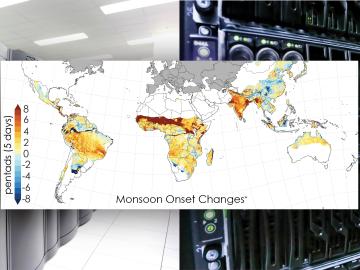
Filter News
Area of Research
- (-) National Security (16)
- (-) Nuclear Science and Technology (7)
- (-) Supercomputing (64)
- Advanced Manufacturing (19)
- Biology and Environment (41)
- Building Technologies (2)
- Computational Biology (1)
- Computational Engineering (3)
- Computer Science (13)
- Energy Science (99)
- Fusion and Fission (5)
- Fusion Energy (4)
- Isotope Development and Production (1)
- Isotopes (19)
- Materials (87)
- Materials Characterization (1)
- Materials for Computing (14)
- Materials Under Extremes (1)
- Mathematics (1)
- Neutron Science (27)
- Quantum information Science (4)
- Transportation Systems (1)
News Type
News Topics
- (-) 3-D Printing/Advanced Manufacturing (6)
- (-) Big Data (7)
- (-) Biomedical (11)
- (-) Computer Science (58)
- (-) Frontier (14)
- (-) Isotopes (4)
- (-) Materials Science (8)
- Advanced Reactors (9)
- Artificial Intelligence (20)
- Bioenergy (7)
- Biology (6)
- Biotechnology (1)
- Buildings (1)
- Chemical Sciences (4)
- Coronavirus (8)
- Critical Materials (3)
- Cybersecurity (18)
- Energy Storage (7)
- Environment (10)
- Exascale Computing (9)
- Fusion (5)
- Grid (7)
- High-Performance Computing (17)
- Machine Learning (11)
- Materials (10)
- Microscopy (5)
- Molten Salt (4)
- Nanotechnology (6)
- National Security (21)
- Neutron Science (11)
- Nuclear Energy (24)
- Partnerships (4)
- Physics (7)
- Polymers (2)
- Quantum Computing (9)
- Quantum Science (15)
- Security (10)
- Simulation (3)
- Space Exploration (6)
- Summit (20)
- Transportation (5)
Media Contacts

A team led by Dan Jacobson of Oak Ridge National Laboratory used the Summit supercomputer at ORNL to analyze genes from cells in the lung fluid of nine COVID-19 patients compared with 40 control patients.

Five researchers at the Department of Energy’s Oak Ridge National Laboratory have been named ORNL Corporate Fellows in recognition of significant career accomplishments and continued leadership in their scientific fields.

Scientists at ORNL used neutron scattering and supercomputing to better understand how an organic solvent and water work together to break down plant biomass, creating a pathway to significantly improve the production of renewable

Scientists from the Department of Energy’s Oak Ridge National Laboratory and a dozen other international research institutions have produced the most elaborate set of projections to date that illustrates possible futures for major monsoon regions.

A team of researchers has performed the first room-temperature X-ray measurements on the SARS-CoV-2 main protease — the enzyme that enables the virus to reproduce.

Oak Ridge National Laboratory researchers have discovered a better way to separate actinium-227, a rare isotope essential for an FDA-approved cancer treatment.

Scientists have tapped the immense power of the Summit supercomputer at Oak Ridge National Laboratory to comb through millions of medical journal articles to identify potential vaccines, drugs and effective measures that could suppress or stop the

Researchers at the Department of Energy’s Oak Ridge National Laboratory are refining their design of a 3D-printed nuclear reactor core, scaling up the additive manufacturing process necessary to build it, and developing methods

OAK RIDGE, Tenn., Feb. 19, 2020 — The U.S. Department of Energy’s Oak Ridge National Laboratory and the Tennessee Valley Authority have signed a memorandum of understanding to evaluate a new generation of flexible, cost-effective advanced nuclear reactors.

A novel approach developed by scientists at ORNL can scan massive datasets of large-scale satellite images to more accurately map infrastructure – such as buildings and roads – in hours versus days.


